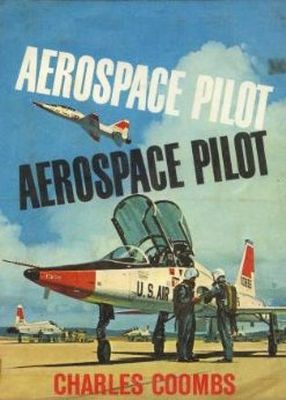

| AEROSPACE PILOT Charles Ira Coombs New York: William Morrow and Co., 1964 (a Morrow Junior Book) |
Rating: 5.0 High |
|||
| LCCN 64-12042 | 224pp. | HC/BWI | $5.75 | |
This book makes fascinating reading for every boy or man who's ever dreamed of becoming a flyer. (Nowadays, of course, girls and women are included.1) If anyone is seriously planning such a step, it is especially valuable, for it follows a typical pilot candidate (the fictional Dan Evans) from Officer Candidate School all the way to jockeying an X-15 at Edwards AFB.
Coombs is a gifted writer. His lively account makes you feel as if you are really there marching to classes, whirling in the Barany Chair, experiencing decompression, or making your first solo flight. At its end, you stand with Evans at the gateway to space, as he gazes up at the Moon and contemplates completing the application to NASA he holds in his hands.
Despite my vantage point of 30 years on, beyond the triumphs and tragedies of Gemini, Apollo, and the space shuttle2 — and all the other changes that have taken place in the world (a world of changes in aerospace technology and politics) — Coombs's account remains valuable as a description of an aerospace career. "Aerospace pilot" is a term of art for, as Coombs points out, the boundary between air and space is indefinite, and craft which can operate routinely in both environments are coming. And if the Moon is not so close in travel time or system-development time as it was when this book was written, it is once again "getting closer all the time."
The book is indexed and provides 98 black-and-white photographs. Coombs was a prolific author, not only on aviation and space but other subjects. I look forward to reading some of his other efforts.3

 To contact Chris Winter, send email to this address.
To contact Chris Winter, send email to this address.